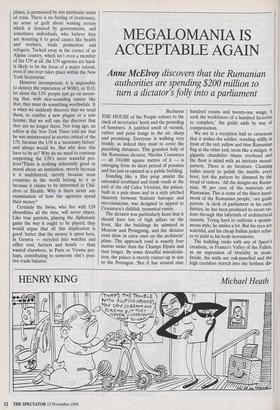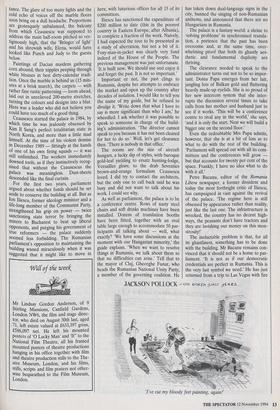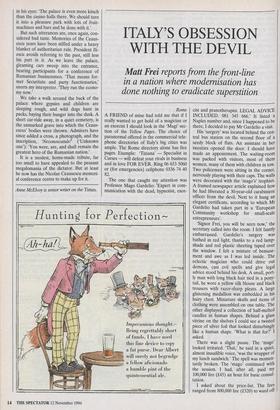MEGALOMANIA IS ACCEPTABLE AGAIN
Anne McElvoy discovers that the Rumanian
authorities are spending $200 million to turn a dictator's folly into a parliament
Bucharest THE HOUSE of the People echoes to the clack of secretaries' heels and the pounding of hammers. A jumbled smell of varnish, rubber and paint hangs in the air, sharp and promising. Everyone is walking very briskly, as indeed they must to cover the punishing distances. This grandest folly of the Rumanian dictator, Nicolae Ceausescu — all 330,000 square metres of it — is emerging from its short period of penance and has just re-opened as a public building.
Standing like a film prop amidst the untended scrubland and trunk roads at the end of the old Calea Victoriei, the palace, built in a pale stone and in a style pitched bizarrely between Stalinist baroque and neo-classicism, was designed to appeal to Ceausescu's childish, tyrannical vanity.
The dictator was particularly keen that it should have lots of high pillars on the front, like the buildings he admired in Moscow and Pyongyang, and the dictator even drew in extra ones on the architects' plans. The approach road is exactly four metres wider than the Champs Elysee and four longer. By some dreadful miscalcula- tion, the palace is merely runner-up in size to the Pentagon. 'But it has around nine hundred rooms and twenty-one wings; it took the workforces of a hundred factories to complete,' the guide adds by way of compensation.
We are in a reception hall so cavernous that it makes the soldier, standing stiffly in front of the red, yellow and blue Rumanian flag at the other end, seem like a midget. A gigantic chandelier blazes overhead and the floor is inlaid with an intricate mosaic pattern. There is no furniture. Cleaning ladies scurry to polish the marble every hour, lest the pattern be dimmed by the tread of visitors. 'All the designs are Ruma- nian, 90 per cent of the materials are Rumanian. This is some of the finest hand- iwork of the Rumanian people,' our guide parrots. A clerk of parliament in his early thirties, he has been produced to escort vis- itors through this labyrinth of architectural insanity. Trying hard to cultivate a sponta- neous style, he smiles a lot. But his eyes are watchful, and his cheap Italian jacket refus- es to yield to his body movements.
The building ranks with any of Speer's creations, or Franco's Valley of the Fallen, as an expression of brutality in stone. Inside, the walls are oak-panelled and the high corridors stretch into the farthest dis- tance. The glare of too many lights and the cold echo of voices off the marble floors soon bring on a dull headache. Proportions are grotesquely unbalanced, the balcony from which Ceausescu was supposed to address the main ball-room pitched so ver- tiginously high, that the 'Bringer of light' and his shrewish wife, Elena, would have looked like Punch and Judy to the guests below.
Paintings of Dacian maidens gathering corn abound, their nipples peeping through white blouses in best dirty-calendar tradi- tion. Once the marble is behind us (15 min- utes at a brisk march), the carpets — with rather fine rustic patterning — loom ahead, laid out in unrelieved 200-metre stretches, turning the colours and designs into a blur. Here was a leader who did not believe you could have too much of a good thing. Ceausescu started the palace in 1984, by which time he was jealously obsessed by Kim II Sung's perfect totalitarian state in North Korea, and more than a little mad himself. At the time of his violent demise in December 1989 — fittingly at the hands of one of his own firing squads — it was still unfinished. The workers immediately downed tools, as if they instinctively recog- nised that without the Ceausescus the palace was meaningless. Dust-sheets descended like the final curtain.
For the first two years, parliament argued about whether funds should be set aside to conserve the building at all. But as Ion Iliescu, former ideology minister and a life-long member of the Communist Party, strengthened his grip on power — twice sanctioning state terror by bringing the miners to Bucharest to beat up liberal °PPonents, and purging his government of true reformers — the palace suddenly seemed less forbidding. The Rumanian parliament's opposition to maintaining the building waned miraculously when it was suggested that it might like to move in here, with luxurious offices for all 15 of its committees.
Iliescu has sanctioned the expenditure of $200 million to date (this in the poorest country in Eastern Europe, after Albania), to complete a fraction of the work. Naively, I had expected the tour to be presented as a study of aberration, but not a bit of it. Foxy-man-in-jacket was clearly very fond indeed of the House of the People. The previous management was just unfortunate. `It is built now. We should use and enjoy it and forget the past. It is not so important.'
Important or not, the past clings to Rumania, despite her attempts to embrace the market and open up the country after decades of isolation. I would like to tell you the name of my guide, but he refused to divulge it. 'Write down that what I have to say is more significant than who I am,' he wheedled. I ask whether it was possible to speak to someone in charge of the build- ing's administration. 'The director cannot speak to you because it has not been cleared for her to do so.' Well, let's get clearance then. 'There is nobody in that office.'
The rooms are the size of aircraft hangars, a lucky dip of styles, with baroque gold-leaf yielding to ersatz hunting-lodge, Versailles gloire, to the drab Seventies brown-and-orange formalism Ceausescu loved. I did try to contact the architects, but the only one to call back said he was busy and did not want to talk about his work. I could see why.
As well as parliament, the palace is to be a conference centre. Rows of nasty steel chairs and soft drinks machines have been installed. Dozens of translation booths have been fitted, together with an oval table large enough to accommodate 50 par- ticipants all talking about — well, what exactly? 'We have some discussions at the moment with our Hungarian minority,' the guide explains. 'When we want to resolve things in Rumania, we talk about them so that no difficulties can arise.' Tell that to the mayor of Cluj, Gheorghe Funar, who heads the Rumanian National Unity Party, a member of the governing coalition. He
has taken down dual-language signs in the city, banned the singing of non-Rumanian anthems, and announced that there are no Hungarians in Rumania.
The palace is a fantasy world: a shrine to `solving problems' in synchronised transla- tion, a pretence that the past has been overcome and, at the same time, over- whelming proof that both its ghastly aes- thetic and fundamental duplicity are thriving.
The clearance needed to speak to the administrator turns out not to be so impor- tant. Doina Papa emerges from her lair, jangling lots of Balkan gold and fluttering heavily made-up eyelids. She is so proud of her new intercom system that she inter- rupts the discussion several times to take calls from her mother and husband just to see if it works. 'This will be a conference centre to rival any in the world,' she says, `and it is only the start. Next we will build a bigger one on the second floor.'
Even the redoubtable Mrs Papa admits, however, that she is at a bit of loss as to what to do with the rest of the building. `Parliament will spread out with all its com- mittees and the conferences will grow but that accounts for twenty per cent of the space. Frankly, I have no idea what to do with it all.'
Petre Bacanu, editor of the Romania Libera newspaper, a former dissident and today the most forthright critic of Iliescu, has campaigned in vain against the revival of the palace. 'The regime here is still obsessed by appearance rather than reality, just like the last one. The infrastructure is wrecked, the country has no decent high- ways, the peasants don't have tractors and they are lavishing our money on this mon- strosity!'
The ineluctable problem is that, for all its ghastliness, something has to be done with the building. Mr Bacanu remains con- vinced that it should not be a home to par- liament. 'It is not as if our democratic credentials are perfect in Rumania. This is the very last symbol we need.' He has just returned from a trip to Las Vegas with fire
JACKSON POLLOCK — Eie OrlacEri 3 (Ass year.R.s., . „ `I've cut my bloody feet painting, again!' in his eyes: The palace is even more kitsch than the casino halls there. We should turn it into a pleasure park with lots of fruit- machines and bars and be done with it.'
But such utterances are, once again, con- sidered bad taste. Memories of the Ceaus- escu years have been stifled under a heavy blanket of authoritarian rule. President Ili- escu avoids referring to the past, still less his part in it. As we leave the palace, gleaming cars sweep into the entrance, bearing participants for a conference of Rumanian businessmen. 'That means for- mer Securitate and party functionaries,' snorts my interpreter. 'They run the econo- my now.'
We take a walk around the back of the palace where gypsies and children are sleeping rough, and wild dogs hunt in packs, baying their hunger into the dusk. A short car-ride away, in a quiet cemetery, is the unmarked grave into which the Ceaus- escus' bodies were thrown. Admirers have since added a cross, a photograph, and the inscription, Weconoscutule (`Unknown one'): 'You were, are, and shall remain the greatest hero of the Rumanian nation.'
It is a modest, home-made tribute, far too small to have appealed to the peasant megalomania of the dictator. But at least he now has the Nicolae Ceausescu memori- al conference centre to make up for it.
Anne McElvoy is senior writer on the Times.




































































 Previous page
Previous page